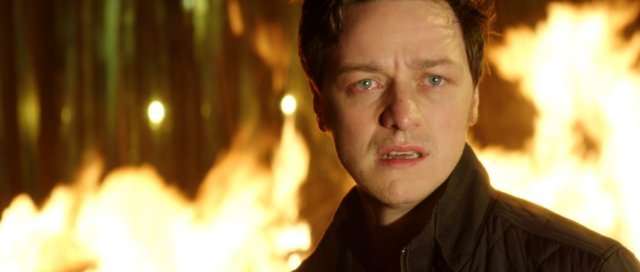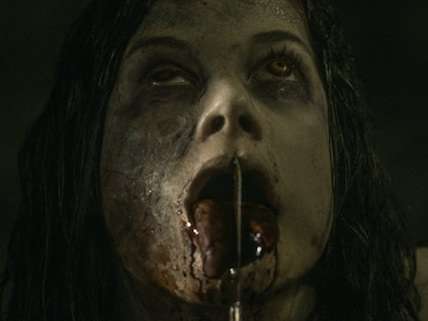Reviewed: Trance and Evil Dead
Danny Boyle's madhouse mystery and Sam Raimi's vintage nightmare revisited.
Danny Boyle's dreamland psycho-thriller Trance elevates plot-knotting mind games to a delirious new level. It would be wrong to say too much about the story's ever-deepening complications, and difficult to do so in any case. Let's just say this:
James McAvoy plays Simon, an employee at a London fine-art auction house. One day a Goya painting called "Witches in the Air" – pointedly featuring a man groping about blindly with a sheet over his head – draws a winning bid of more than $40-million. At just this moment, a group of what I suppose would have to be called art thugs bursts into the auction room, led by the decidedly un-thuglike Franck (Vincent Cassel – throw a sporty scarf on him and he'd fit right into an Hermès ad). As tear-gas canisters roll across the floor, Simon grabs the Goya and runs off to hide it downstairs. When Franck eventually confronts him, there's a tussle; Simon gets knocked on the head, and when he awakes from a coma in the hospital a few days later, he has no recollection of where he hid the painting.

Then we learn that Simon was in on the theft. And now that he's claiming not to recall the painting's current location, Franck – after expressing his displeasure in a most painful way -- decides to take him to a hypnotherapist, a woman named Elizabeth (Rosario Dawson), to recover his buried memory. Simon wears a wire to her office so that Franck can monitor their sessions from a car outside. But Elizabeth soon intuits this, and she soon gets to know Franck, too. And being the movie's designated femme fatal, she has a deadly backstabbing agenda of her own.
That'll have to do. As Simon drifts into his hypnotic trances, the movie becomes a disorienting swirl of dreams and confusions. There's a red car driven by a mysterious young woman, and a room full of "lost" paintings by Rembrandt, Degas, Manet and Van Gogh. (These works, recreated here, actually are lost -- stolen from a Boston museum in 1990, they've never been recovered.) There's also some tricky business with an iPad, a few thoughts about the absence of pubic hair in classical paintings, and a startlingly blunt moment of full-frontal nudity.
Is Simon losing his mind? Are we losing ours? Or was Boyle, who made the movie while planning his spectacular opening ceremony for last summer's London Olympics, just heavily frazzled himself? The film's original script, by Joe Ahearne, had been turned into a British TV movie in 2001. Boyle, who had long had his eye on the property, brought in his longtime collaborator John Hodge to punch it up. By the time the story reaches its giddy conclusion, we too have been expertly worked over.
With all of its flashbacks and fakeouts, the movie could be said to be wildly over-determined, or maybe just silly. But it has propulsive energy, and a gorgeous look. (Some of cinematographer Anthony Dod Mantle's elegant shots are composed like paintings themselves.) Is it all too much? Maybe. Is that such a bad thing?
Evil Dead

This exercise in classical blood-bath monotony certainly does its grisly job, but little more. Evil Dead is a remake of The Evil Dead, the micro-budget 1981 horror movie that launched Sam Raimi as a director and his star, Bruce Campbell, as an enduring cult personage. The new film tweaks the original story a bit; but while it offers a full complement of updated shocks, there are no surprises. What we have here, more than anything else, is a tribute to a much-admired classic whose arterial tropes have long since saturated the fright-flick genre.
Raimi and Campbell, who also collaborated on two earlier sequels to the first movie, are producers here; directorial duties have been handed off to Uruguayan filmmaker Fede Alvarez, who drew much notice with his 2009 giant-robot short, Panic Attack! The script is by Alvarez and his writing partner, Rodo Sayagues, with Diablo Cody, of all people, tiptoeing in to impart an authentic youth-of-today tang to the dialogue. (Props to her, presumably, for "I just don't wanna become the Devil's bitch!")
The picture begins with a gruesome prologue, which is new. But then, as in the original picture, we see a group of friends – two guys, three girls again – arriving at a gloomy cabin in the woods. The unsuspecting youths aren't on vacation this time; Mia (Jane Levy) has come to quick-kick a drug habit with support from her brother, David (Shiloh Fernandez); his girlfriend, a dithery doctor named Natalie (Elizabeth Blackmore); his nervous pal Eric (Lou Taylor Pucci); and a young nurse, Olivia (Jessica Lucas), who has brought along some meds and a syringe, which will come in handy. (Arrange these characters' first-name initials in a certain order and you get a rather Raimi-esque joke.)
Inside the cabin, once again, is an evil book that's very much like the ancient Sumerian relic in the first film, which you'll recall was written in blood and bound in human skin. The new tome is similarly ghastly, and it has a warning scrawled inside: "Leave this book alone." Naturally, the scholarly Eric ignores that, and soon realizes that this foul text is an instrument for summoning demons. Very quickly the young visitors begin to morph into cackling, slobbery horrors. Anyone who's seen the original Evil Dead will already know all this, and will be hanging around mainly in hope of fresh new gross-outs.
And there are indeed several. The attack of the killer vines in a forest is a reprise of a famous Raimi scene, but later there's a power-saw-to-the-face shot that's pretty amusing. And along with much squirty dismemberment, there's a drool-soaked scene that gives new meaning to the phrase "speaks with forked tongue." Unfortunately – well, depending on your taste in these things – there are also a nail-gun assault and a crowbar beating that push the movie right up to the edge of torture porn.
It never really crosses that line, though. The film's inventory of nouveau bloody jolts simply illustrates how far we've traveled down the road of pop Guignol since 1981. And director Alvarez has a fanboy flair for this stuff. His lurid lighting is dismal in the grand tradition, and his rejection of CGI in favor of old-fashioned practical effects allows him to approach vintage cheesiness as a style, even though it's no longer a necessity. But he's constrained at every turn by the need to replicate a brand-name property whose groundbreaking days are long past. Gorehounds may flock to this picture, but will they still be buzzing about it 32 years from now?


Show Comments (33)